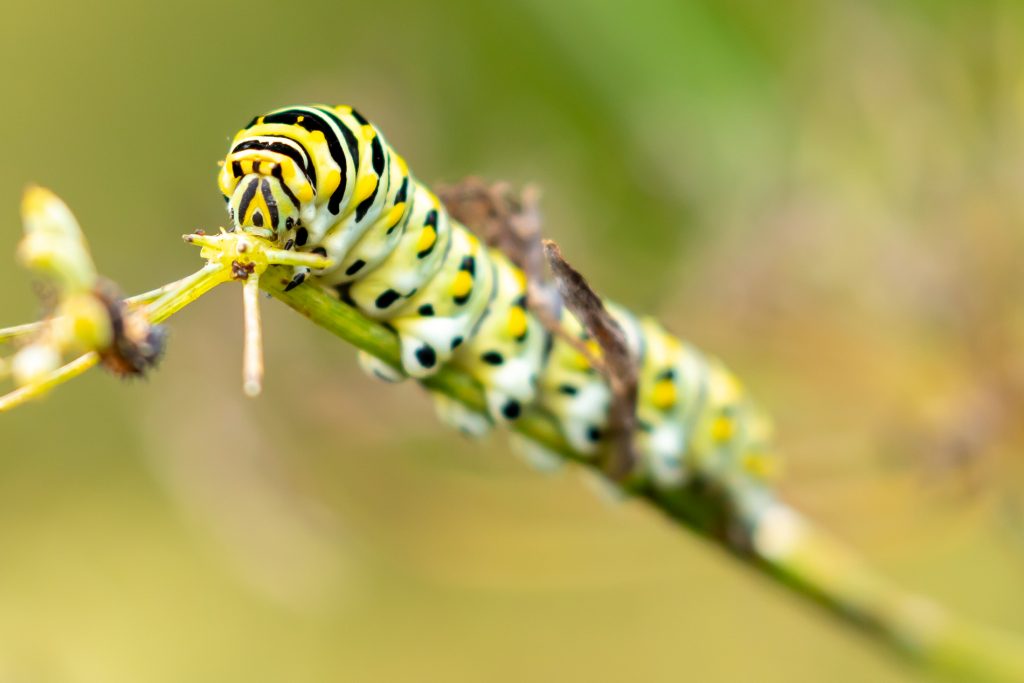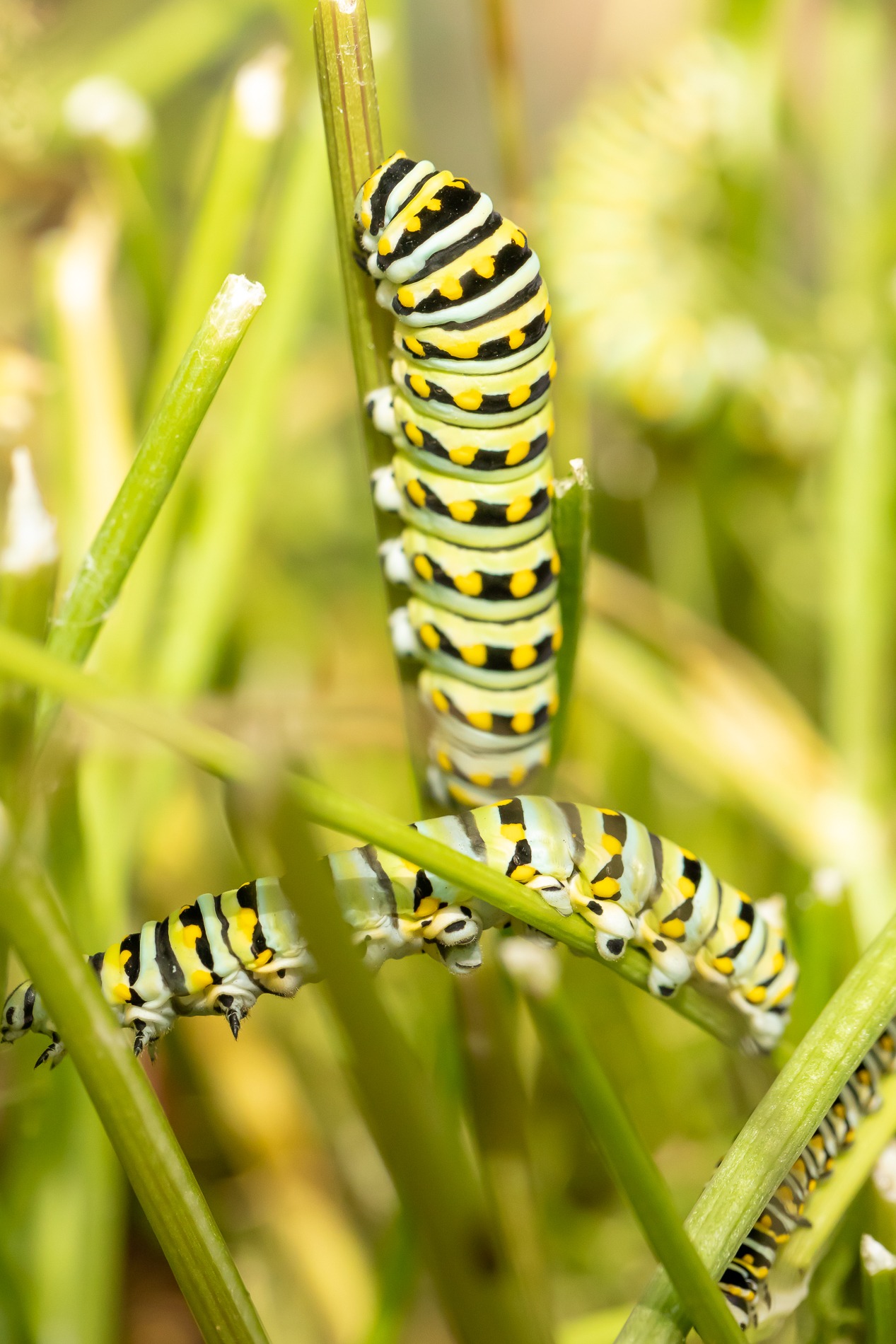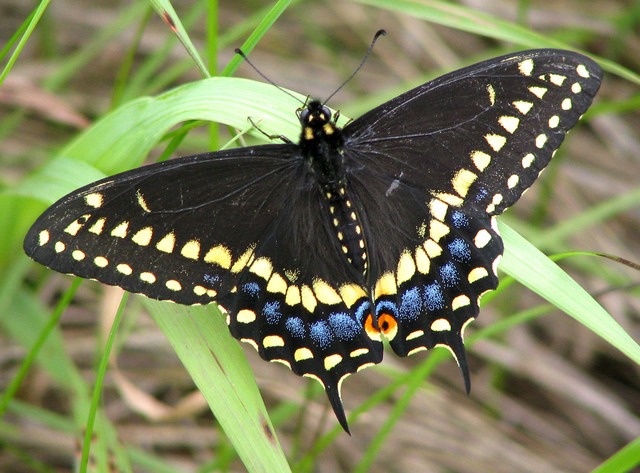Investigating Black Swallowtail Caterpillars’ Behavior
Recently we got a question from a visitor about his black swallowtail butterfly caterpillars. After visiting M&T Bank Butterflies LIVE! with his grandson, he decided to grow some parsley in hopes of attracting more native butterflies to his garden. Fortunately, he witnessed a black swallowtail butterfly laying eggs on the parsley plants and those larva hatching and growing large. However, his many caterpillars suddenly disappeared from the host plants outside in his garden, and he had also found a dead caterpillar at the bottom of one of his plants. He reached out to us because he was curious to know what might be the cause of his caterpillars disappearing. Luckily we have an expert, butterfly curator and exhibitions assistant, Mary Lincoln, to help solve the mystery. Earlier this year she wrote a blog post providing some great information on raising Black Swallowtail caterpillars to butterflies. Just to refresh, she reminded us that black swallowtail butterflies emerge from a chrysalis in 7 to 10 days. If it’s hotter, they’ll come out sooner welcoming the warmth. During these transitional fall months, days are mixed between a crisp chilly and warm sunny (and the occasional, really hot). Black Swallowtail caterpillars may seem to be acting strangely during this time because of the shift in weather. What are the scenarios that these cute critters are getting into?
We can start with a pretty normal scenario. Black swallowtail caterpillars are eating like they should, getting large, and disappearing. What happened? These caterpillars are on track for graduation to black swallowtail butterflies. They’ve eaten as much as they can from their host plant and are ready to move out and find a new place to pupate. All of the caterpillars try to get as far away from their host plant as possible. This strategy ensures predators won’t find all the black swallowtails defenseless as chrysalises stuck to the host plant. This happens a few times during the summer as there are multiple broods of black swallowtail butterflies and isn’t specific to the fall weather, it’s common behavior. Soon the black swallowtail butterflies will emerge and will be flying all over.
Dia-PAUSE
Let’s say your black swallowtail caterpillars are eating well, getting large, and turning into pupae, but you don’t see butterflies flying around. You may wonder, where did they go? Why aren’t they fabulously re-entering the world as black swallowtail butterflies? During this sometimes-warm-sometimes-chilly time of the year, black swallowtails may enter diapause or overwintering hibernation mode. They, along with others in the Papilio genus, tend to do this during autumn. As a survival strategy, diapause allows them to brace for the colder weather and go into well, for lack of a better word, pause. To check that a chrysalis is hibernating and not a dead one, you can look at the color. Dead pupae will have a sickly black or dark brown color. Black swallowtail chrysalises maybe a brown color already, but ones that have perished are darker and could be giving off a smell.
Timelapse video of the big transition! Video by Butterfly Curator Daniel Wright.
Keeping Black Swallowtail Caterpillars Safe
So then, what if the caterpillars never seem to grow full-size? You watch them squirm around on your parsley plant. They’re small and cute, but one day, you stop seeing them around. Unfortunately, predators, like wasps, could have gotten to them. A great way to prevent this from happening, and for the chance to see black swallowtail butterflies emerge, is to provide a shelter for the caterpillars. A quick note from Mary Lincoln again, “while some kinds of wasps are parasites and predator of caterpillars, there are also types that are valuable pollinators. I’m just afraid people will kill all the wasps in their yard for fear they’re eating their butterflies!” Surrounding the black swallowtail caterpillars and their host plants with a mesh bag can keep them safe. You could also bring the caterpillars inside to a sunroom or porch.
Leaves are dropping and the weather is changing. Though black swallowtail caterpillars don’t typically wait until the leaves change to go through their huge transition, we can watch for their change in behavior for the weather.
As for our visitor, he mentioned that as for the 40-something caterpillars squirming around his garden, he never found a single chrysalis. These caterpillars either scooted far, far, away or were extremely good at camouflaging themselves. We like to think it was the latter. His plans for next year are to instead bring his parsley plant inside his screened-in porch to make sure the caterpillars are out of danger and so he can witness the full cycle!
You can drop by the M&T Bank Butterflies LIVE! exhibit at the Garden to find black swallowtail butterflies and more at all stages of their metamorphosis. Go ahead and ask the talented Butterflies LIVE! staff about our butterflies and enjoy the fluttering of them all around you. Don’t miss the closing weekend events on Saturday, October 12, and Sunday, October 13, 2019, for butterfly and moth talks, crafts, and a pollinator parade!


